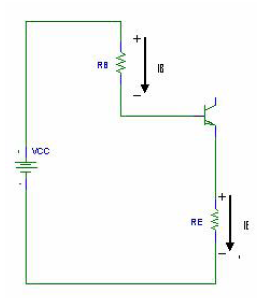• It can be shown that, including an emitter resistor in the fixed bias circuit
improves the stability of Q point.
• Thus emitter bias is a biasing circuit very similar to fixed bias circuit with an
emitter resistor added to it.
Input loop
• Writing KVL around the input loop we get,
VCC = IBRB + VBE + IERE (1)
We know that,
IE = (β+1)IB (2)
Substituting this in (1), we get,
VCC = IBRB + VBE + (β+1)IBRE
VCC – VBE = IB(RB + (β+1) RE)
Solving for IB:
IB = (VCC – VBE ) /[(RB + (β+1) RE)]
7
The expression for IB in a fixed bias circuit was,
IB = (VCC – VBE ) /RB
Equivalent input loop:
• REI in the above circuit is (β+1)RE which means that, the emitter resistance that is
common to both the loops appears as such a high resistance in the input loop.
• Thus Ri = (β+1)RE ( more about this when we take up ac analysis)
Output loop
Collector – emitter loop
Applying KVL,
VCC = ICRC + VCE + IERE
IC is almost same as IE
8
Thus,
VCC = ICRC + VCE + ICRE
= IC (RC + RE) +VCE
VCE = VCC - IC (RC + RE)
Since emitter is not connected directly to ground, it is at a potential VE, given by,
VE = IERE
VC = VCE + VE OR VC = VCC – ICRC
Also, VB = VCC – IBRB OR VB = VBE + VE









0 comments